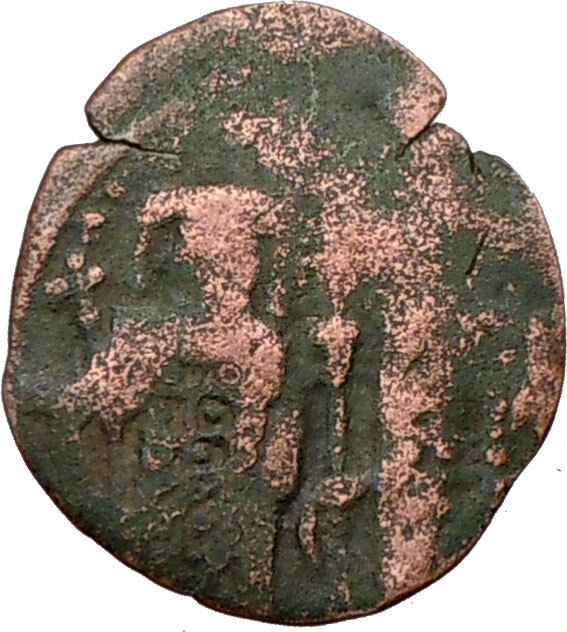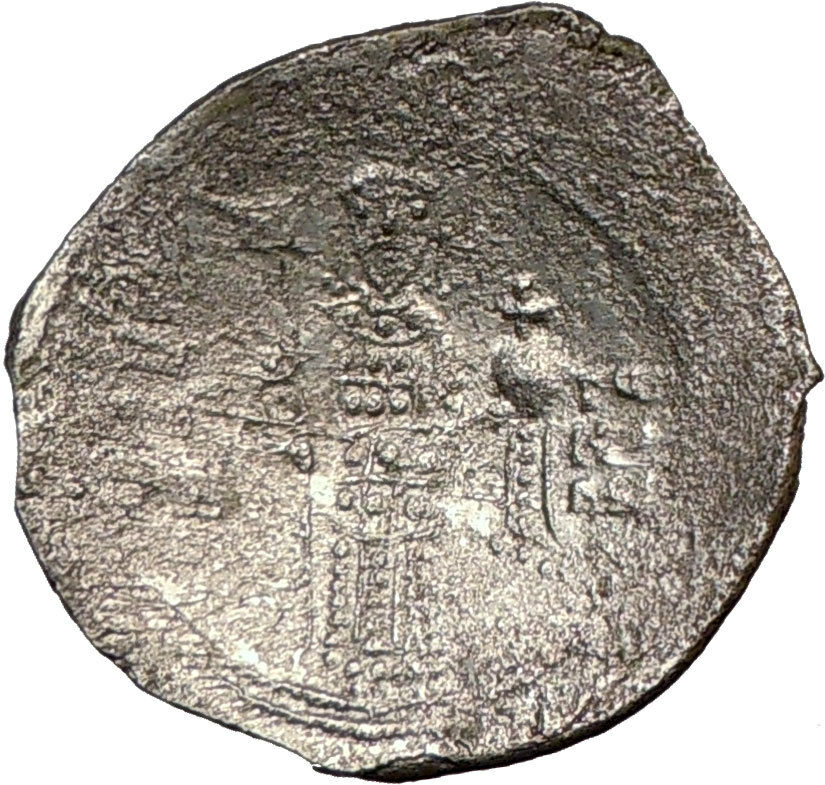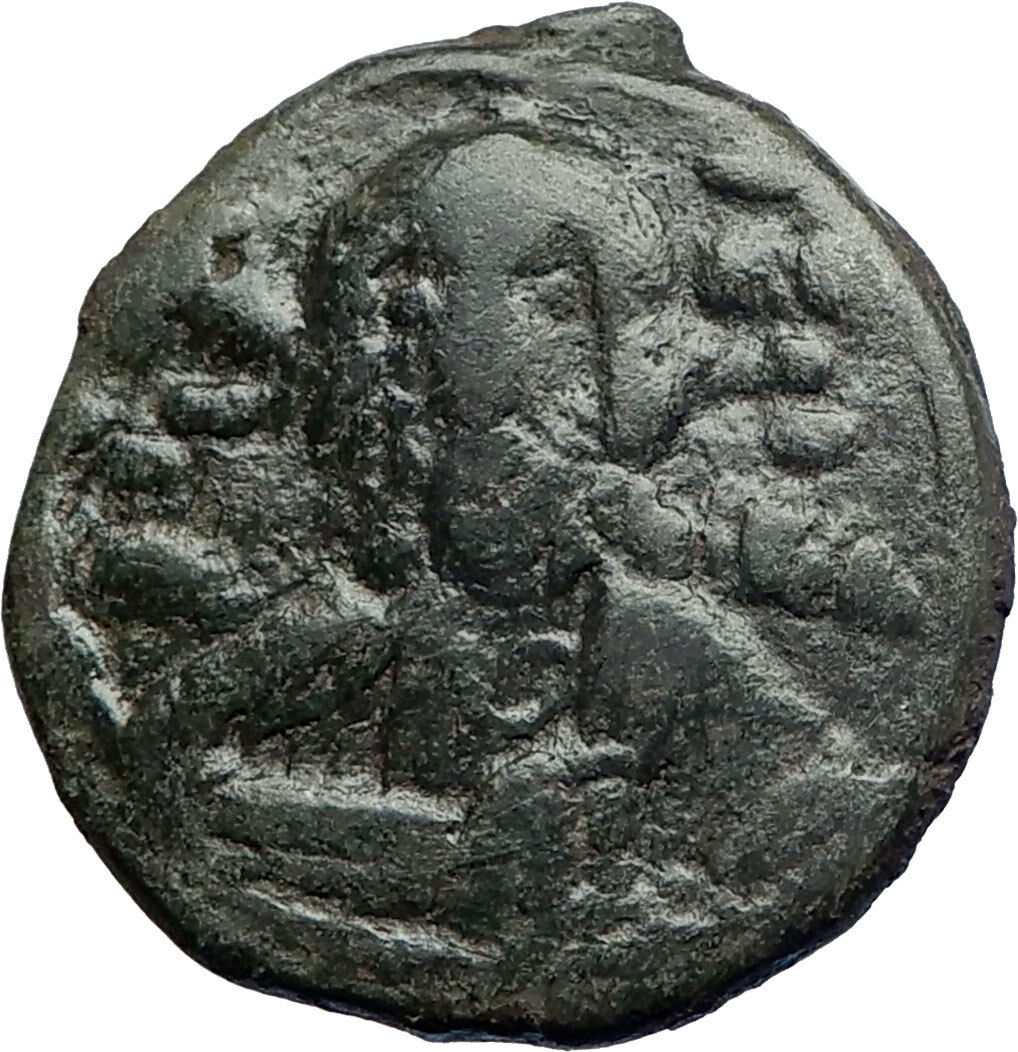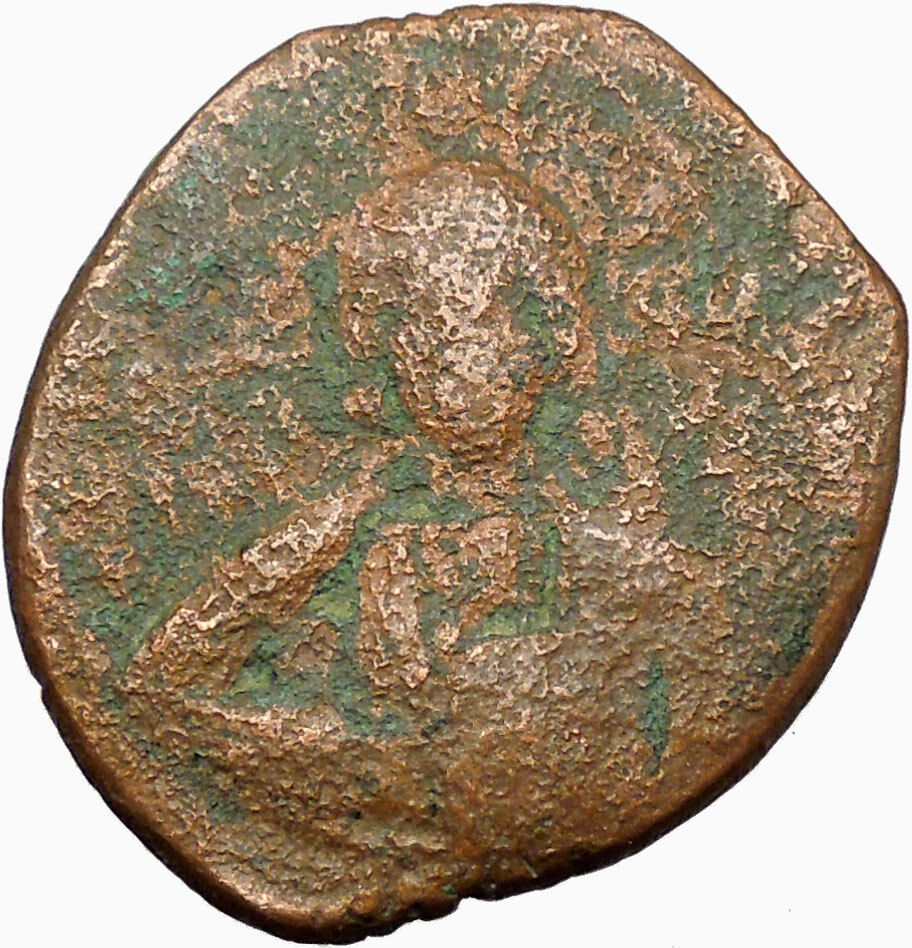|
Byzantine Empire – Anonymous Class I
Bronze Follis 25mm (3.30 grams)
Struck during the reign of Nicephorus III – 24 March 1078 – 4 April 1081 A.D.
Reference: Sear 1889
Bust of Jesus Christ facing, wearing nimbus crown, pallium and colobium, and raising right hand in benediction, in left hand, the book of Gospels, IC to left, XC to right; within border.
Latin cross, with X at center, and globule and two pellets at each extremity; in lower field, on either side, floral ornament; in upper field, on either side, crescent.
For more than a century, the production of Follis denomination Byzantine coins had religious Christian motifs which included included Jesus Christ, and even Virgin Mary. These coins were designed to honor Christ and recognize the subservient role of the Byzantine emperor, with many of the reverse inscriptions translating to “Jesus Christ King of Kings” and “May Jesus Christ Conquer”. The Follis denomination coins were the largest bronze denomination coins issued by the Byzantine empire, and their large size, along with the Christian motif make them a popular coin type for collectors. This series ran from the period of Byzantine emperors John I (969-976 A.D.) to Alexius I (1081-1118 A.D.). The accepted classification was originally devised by Miss Margaret Thompson with her study of these types of coins. World famous numismatic author, David R. Sear adopted this classification system for his book entitled, Byzantine Coins and Their Values. The references about this coin site Mr. Sear’s book by the number that they appear in that work. The class types of coins included Class A1, Class A2, Class A3, Class B, Class C, Class D, Class E, Class F, Class G, Class H, Class I, Class J, Class K.
-
Read the JESUS CHRIST Anonymous Class A-N Byzantine Follis Coins Reference and Guide
-
See ALL the Jesus Christ Anonymous Follis coins for sale.
-
See ALL coins bearing Jesus Christ or related available for sale.
You are bidding on the exact item pictured, provided with a Certificate of Authenticity and Lifetime Guarantee of Authenticity.
 Jesus (7-2 BC to AD 30-33), also referred to as Jesus of Nazareth or Jesus Christ, is the central figure of Christianity, whom the teachings of most Christian denominations hold to be the Son of God. Christians believe Jesus is the awaited Messiah (or Christ, the Anointed One) of the Old Testament. Jesus (7-2 BC to AD 30-33), also referred to as Jesus of Nazareth or Jesus Christ, is the central figure of Christianity, whom the teachings of most Christian denominations hold to be the Son of God. Christians believe Jesus is the awaited Messiah (or Christ, the Anointed One) of the Old Testament.
Virtually all modern scholars of antiquity agree that Jesus existed historically, and historians consider the Synoptic Gospels (Matthew, Mark and Luke) to be the best sources for investigating the historical Jesus. Most scholars agree that Jesus was a Galilean, Jewish rabbi who preached his message orally, was baptized by John the Baptist, and was crucified by the order of the Roman Prefect Pontius Pilate. In the current mainstream view, Jesus was an apocalyptic preacher and the founder of a renewal movement within Judaism, although some prominent scholars argue that he was not apocalyptic. After Jesus’ death, his followers believed he was resurrected, and the community they formed eventually became the Christian church. The widely used calendar era, abbreviated as “AD” from the Latin “Anno Domini” (“in the year of our Lord”) or sometimes as “CE”, is based on the birth of Jesus.
 Christians believe that Jesus has a “unique significance” in the world. Christian doctrines include the beliefs that Jesus was conceived by the Holy Spirit, was born of a virgin named Mary, performed miracles, founded the Church, died by crucifixion as a sacrifice to achieve atonement, rose from the dead, and ascended into Heaven, whence he will return. Most Christians believe Jesus enables humans to be reconciled to God, and will judge the dead either before or after their bodily resurrection, an event tied to the Second Coming of Jesus in Christian eschatology; though some believe Jesus’s role as savior has more existential or societal concerns than the afterlife, and a few notable theologians have suggested that Jesus will bring about a universal reconciliation. The great majority of Christians worship Jesus as the incarnation of God the Son, the second of three persons of a Divine Trinity. A few Christian groups reject Trinitarianism, wholly or partly, as non-scriptural. Christians believe that Jesus has a “unique significance” in the world. Christian doctrines include the beliefs that Jesus was conceived by the Holy Spirit, was born of a virgin named Mary, performed miracles, founded the Church, died by crucifixion as a sacrifice to achieve atonement, rose from the dead, and ascended into Heaven, whence he will return. Most Christians believe Jesus enables humans to be reconciled to God, and will judge the dead either before or after their bodily resurrection, an event tied to the Second Coming of Jesus in Christian eschatology; though some believe Jesus’s role as savior has more existential or societal concerns than the afterlife, and a few notable theologians have suggested that Jesus will bring about a universal reconciliation. The great majority of Christians worship Jesus as the incarnation of God the Son, the second of three persons of a Divine Trinity. A few Christian groups reject Trinitarianism, wholly or partly, as non-scriptural.
In Islam, Jesus (commonly transliterated as Isa) is considered one of God’s important prophets and the Messiah, second in importance only to Muhammad. To Muslims, Jesus was a bringer of scripture and was born of a virgin, but was not the Son of God. According to the Quran, Jesus was not crucified but was physically raised into Heaven by God. Judaism rejects the belief that Jesus was the awaited Messiah, arguing that he did not fulfill the Messianic prophecies in the Tanakh.
 Nikephoros III Botaneiates, Latinized as Nicephorus III Botaniates (Greek: Νικηφόρος Βοτανειάτης, c. 1002 – 10 December 1081) was Byzantine emperor from 1078 to 1081. He belonged to a family which claimed descent from the Byzantine Phokas family. Nikephoros III Botaneiates, Latinized as Nicephorus III Botaniates (Greek: Νικηφόρος Βοτανειάτης, c. 1002 – 10 December 1081) was Byzantine emperor from 1078 to 1081. He belonged to a family which claimed descent from the Byzantine Phokas family.
Early career
Nikephoros Botaneiates had served as general from the reign of Constantine IX. Drawn to politics, he had been an active participant in the uprising that brought Isaac I to the throne in 1057, including a prominent role in the Battle of Petroe. Although considered a competent general, he had suffered a number of humiliating setbacks throughout his career. In 1064, he, together with Basil Apokapes, doux of Paradounavon, defended the Balkan frontiers against the invading Oghuz Turks, but was defeated and suffered the humiliation of being taken captive. However, the outbreak of an epidemic soon began decimating the Turks and the prisoners were recovered, while the survivors were quickly recruited in the Byzantine army.
In 1067, he had been considered as a possible husband for the empress Eudokia Makrembolitissa, widowed wife of Constantine X, but she eventually set her heart on Romanos IV Diogenes. Excluded from Romanos’s campaign at Manzikert, he retired to his estates in Anatolia. Eventually, under Michael VII Doukas, he became strategos of the Anatolic theme and commander of the troops in Asia Minor. Here he participated in the shambolic acts that crippled the empire’s eastern provinces, including his strategic retreat when Caesar John Doukas was confronting Norman mercenary rebels, resulting in the humiliating defeat of the Byzantine army, and the capture of John Doukas.
In 1078 he revolted against Michael VII and his finance minister Nikephoritzes, and with the support of the Seljuk Turks who provided him with valuable troops he marched upon Nicaea, where he proclaimed himself emperor. In the face of another rebellious general, Nikephoros Bryennios, his election was ratified by the aristocracy and clergy, while Michael VII abdicated and became a monk. On 24 March 1078, Nikephoros III Botaneiates entered Constantinople in triumph and was crowned by Patriarch Kosmas I of Constantinople. With the help of his general Alexios Komnenos, he defeated Bryennios and other rivals, but failed to clear the invading Turks out of Asia Minor.
Reign
To solidify his position, on the death of his second wife Nikephoros III sought to marry Eudokia Makrembolitissa, the mother of Michael VII and the widow of Constantine X and Romanos IV. This plan was undermined by the Caesar John Doukas, and Nikephoros instead married Maria of Alania. They married in contravention of church canons, as Maria was still at that time, the wife of Michael VII who had entered the monastery of Stoudios. Nevertheless, Nikephoros did not recognize the succession rights of Maria’s son Constantine Doukas, while his plan to promote his worthless nephew Synadenos as co-emperor exposed him to the suspicion and plots of the surviving portions of the Doukas faction at court. Nikephoros’ administration did not win him much support, as his favored courtiers alienated much of the older court bureaucracy and failed to stop the devaluation of the Byzantine currency.
Almost immediately, the uprisings began. Apart from the discontent of the Byzantine aristocracy, several Armenian princes in Asia Minor attempted to establish their independence from the empire. Two Paulician leaders launched their own rebellion in Thrace, in a brutal religious conflict that was not easily suppressed. Consequently, Nikephoros became increasingly dependent on the support of Alexios Komnenos, who successfully defeated the rebellion of Nikephoros Basilakes in the Balkans (1079) and was charged with containing that of Nikephoros Melissenos in Anatolia (1080). The Byzantine Empire also faced foreign invasion, as the Norman Duke Robert Guiscard of Apulia declared war under the pretext of defending the rights of young Constantine Doukas, who had been engaged to Robert’s daughter Helena. As Alexios was entrusted with substantial armed forces to combat the impending Norman invasion, the Doukas faction, led by the Caesar John, conspired to overthrow Nikephoros and replace him with Alexios. Failing to secure the support of either the Seljuk Turks or Nikephoros Melissenos (both parties being his traditional enemies), Nikephoros III was forced to abdicate in favour of the Komnenos dynasty, to which he was connected through the engagement of his grandson to the daughter of Alexios’s older brother Manuel. The deposed emperor retired into the monastery that he had endowed and died later the same year.
Nikephoros III in fiction
Nicephorus III is also a fictional Byzantine Emperor ruling in the beginning of the 14th century in Harry Turtledove’s alternate history novel Agent of Byzantium.
|




 Authentic Ancient Coin of:
Authentic Ancient Coin of:  Jesus (7-2 BC to AD 30-33), also referred to as Jesus of Nazareth or Jesus Christ, is the central figure of Christianity, whom the teachings of most Christian denominations hold to be the Son of God. Christians believe Jesus is the awaited Messiah (or Christ, the Anointed One) of the Old Testament.
Jesus (7-2 BC to AD 30-33), also referred to as Jesus of Nazareth or Jesus Christ, is the central figure of Christianity, whom the teachings of most Christian denominations hold to be the Son of God. Christians believe Jesus is the awaited Messiah (or Christ, the Anointed One) of the Old Testament. Christians believe that Jesus has a “unique significance” in the world. Christian doctrines include the beliefs that Jesus was conceived by the Holy Spirit, was born of a virgin named Mary, performed miracles, founded the Church, died by crucifixion as a sacrifice to achieve atonement, rose from the dead, and ascended into Heaven, whence he will return. Most Christians believe Jesus enables humans to be reconciled to God, and will judge the dead either before or after their bodily resurrection, an event tied to the Second Coming of Jesus in Christian eschatology; though some believe Jesus’s role as savior has more existential or societal concerns than the afterlife, and a few notable theologians have suggested that Jesus will bring about a universal reconciliation. The great majority of Christians worship Jesus as the incarnation of God the Son, the second of three persons of a Divine Trinity. A few Christian groups reject Trinitarianism, wholly or partly, as non-scriptural.
Christians believe that Jesus has a “unique significance” in the world. Christian doctrines include the beliefs that Jesus was conceived by the Holy Spirit, was born of a virgin named Mary, performed miracles, founded the Church, died by crucifixion as a sacrifice to achieve atonement, rose from the dead, and ascended into Heaven, whence he will return. Most Christians believe Jesus enables humans to be reconciled to God, and will judge the dead either before or after their bodily resurrection, an event tied to the Second Coming of Jesus in Christian eschatology; though some believe Jesus’s role as savior has more existential or societal concerns than the afterlife, and a few notable theologians have suggested that Jesus will bring about a universal reconciliation. The great majority of Christians worship Jesus as the incarnation of God the Son, the second of three persons of a Divine Trinity. A few Christian groups reject Trinitarianism, wholly or partly, as non-scriptural. Nikephoros III Botaneiates, Latinized as Nicephorus III Botaniates (Greek: Νικηφόρος Βοτανειάτης, c. 1002 – 10 December 1081) was Byzantine emperor from 1078 to 1081. He belonged to a family which claimed descent from the Byzantine Phokas family.
Nikephoros III Botaneiates, Latinized as Nicephorus III Botaniates (Greek: Νικηφόρος Βοτανειάτης, c. 1002 – 10 December 1081) was Byzantine emperor from 1078 to 1081. He belonged to a family which claimed descent from the Byzantine Phokas family.




